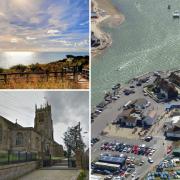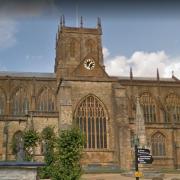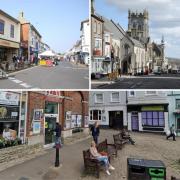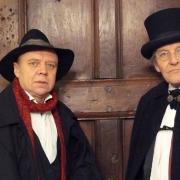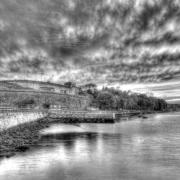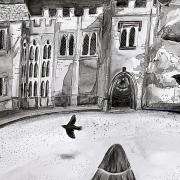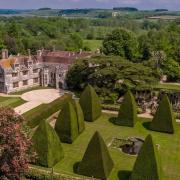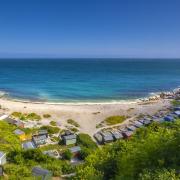Steve Roberts reveals some of the curious facts about Bournemouth and the famous people that once called it home.

Jack the Ripper in Dorset
'Jack the Ripper in Dorset' was, of course, an unidentified serial killer who stalked London's East End in 1888, committing five (possibly more) murders. So where does Dorset fit in to this macabre picture? One of the investigating officers was Frederick Abberline (1843-1929), who was born in Blandford. In 1904 he retired to Bournemouth to 'Estcourt' at 195, Holdenhurst Road - where he lived until his death in 1929. There's a blue plaque on the house commemorating his residence.
Abberline's prime suspect was George Chapman (born Seweryn Klosowski in Poland in 1865). When Chapman was arrested, and subsequently hanged, for a trio of poisonings, Abberline felt compelled to utter: "You've got Jack the Ripper at last!" He was almost certainly wrong. Abberline has been depicted on screen a few times, but always incorrectly. It's enough to make him turn in his Bournemouth grave, which is at Cemetery Junction.

A Solitary Street
One oft-posed question is, why doesn't Bournemouth have a High Street? Though The Square is very much at the centre of things (though strictly speaking it's not a square), the town's meandering thoroughfares, which date back to Victorian town planning, might help explain why there is no 'High Street', as such.
There is only one 'street' in Bournemouth - Orchard Street - a short cut in the town centre connecting Commercial Road and Terrace Road. But why is it Bournemouth's only street? Well, the word is that the town's early denizens did not like the suffix 'street' with its allegedly working-class connotations (think Coronation Street). They preferred the grander sounding roads, avenues and drives. As for the Orchard bit, well there was an orchard behind Commercial Road, back in the days of 'Bourne Tregonwell'. Though there's certainly no sign of it today!

The Russians Are Coming!
Bournemouth has attracted some fascinating residents during its brief 200 year history, including a colony of Russians who lived in Southbourne around the turn of the 20th century. Fleeing Tsarist oppression, they set up home in the old waterworks in Iford Lane where they printed and distributed the works of Leo Tolstoy (of War and Peace fame). There's a blue plaque on the old pumping house to this effect. One of the émigrés, Alexander Sirnis, fathered a child, Melita Norwood (1912-2005), who was born in Bournemouth and went on to pass Anglo-American atom bomb secrets to the KGB.

A Royal Relative in Southbourne
Do you know how old Bournemouth really is? Respondents will often quote 1810, when Lewis Tregonwell began building his 'first house' (now the Royal Exeter Hotel). However, there are older buildings in the modern Borough of Bournemouth because as the town grew it swallowed up older properties in the surrounding area.
In 1901 Southbourne, among other places, was added to the lands of this 'new kid on the block'. With Southbourne came Stourfield House. A lawyer called Edmund Bott (1740-88) built the house (c1766), so it pre-dates Tregonwell's dwelling by over 40 years. A later resident was Mary Bowes, Countess of Strathmore and Kinghorne (1749-1800), who lived at Stourfield House from 1795 until her death. This slightly eccentric Countess liked to set places for her pet dogs at the dinner table (as you do). She was also an ancestor of HM Queen Elizabeth II.

From pier to practice
One of the best ways to get to know a town and its history is to walk around it. Lesser Known Bournemouth includes seven town walks, one of which is around Muscliffe, Throop and Holdenhurst, in the north of the borough. It was here that I found myself gazing at the James Fisher Medical Centre (built in 1986) in Tolpuddle Gardens. It's an area I know well as we lived in Muscliffe for many years. But it was only recently that I unravelled the story behind the medical centre's unusual roof embellishment.
This is the original housing for the clock which was on the former entrance of Bournemouth Pier (1930). Damaged by a bomb blast during World War Two, the pier entrance was finally demolished in 1980 to make way for today's construction. The four clock faces have been replaced by stained glass, and it has found itself a new home atop the medical centre.

A Gentle Giant in Boscombe
The Ashleigh Hotel in Southcote Road, Boscombe was once a house named 'Moyuen', home to the extraordinary Chang Woo Gow (1846-93). Standing eight-feet tall and weighing in at 26 stone, he was known as 'Chang the Chinese Giant' and toured the world as a 'curiosity', which earned him a decent living at the time. He suffered from TB, which explains why Bournemouth, originally a health resort, attracted him there in 1890. Here he ran a Chinese tea room with his wife. He finally succumbed to his illness in 1893 and was buried alongside his wife, who had died just four months earlier, at Wimborne Road Cemetery.

Beats at The Old Fire Station
I worked in Holdenhurst Road for nearly 30 years. It was my 'work station'. In fact, the road is replete with stations as we have Bournemouth Railway Station (1885), a fine Victorian train shed, and also The Old Fire Station which opened in 1902 with horse-drawn appliances. It was a 1930s' upgrade that converted it into a modern fire station which could accommodate four engines.
I'm intrigued by the way buildings get re-purposed in this town, and this fire station is a cracking example. In 1994 The Old Fire Station was converted into a night-club and live music venue. When I was putting together Lesser Known Bournemouth, I interviewed the venue's manager, Sam Cox who told me the building retains many original features, including its stone façade and a 47 foot brass pole, believed to be the longest in the UK Fire Service.

Dry Bournemouth
As a dedicated teetotaller, I've always liked the story surrounding Granville Chambers on Richmond Hill. Built in 1891 as a booze-free temperance hotel, it became the Granville Hotel (1900-1930) in memory of Dr Augustus Granville (1783-1872), the man who helped put Bournemouth on the map as a health resort. He wrote The Spas of England and predicted that Bournemouth would become the UK's premier resort, as its waters were free of 'dung infiltration'. The building was converted to offices in 1930.
The temperance movement was big business in Victorian times. The first temperance hotel opened in 1833, four years before Queen Victoria's accession, and in 1859 there was an attempt to get a prohibition bill through Parliament, which would have banned the consumption of alcohol in the UK. Needless to say, it was defeated in the Commons. Tea anyone?

Tony Hancock's First Gig
The Blood Donor (1961) remains one of the best-known episodes from the comedy series Hancock. It features the legendary Tony Hancock as he donates blood for the first time and is delighted to learn he has a very rare blood group. Cutting himself later with a bread knife, he is then given back his own blood in a transfusion.
Tony Hancock (1924-68) took his first steps in comedy while living in Bournemouth. His father was a hotelier here, which is how Tony came to live at what was the Durlston Court Hotel (today's Hotel Celebrity), in Gervis Road. There's a blue plaque at the entrance. His first performance was at the Catholic Church of the Sacred Heart on Richmond Hill, where his risqué material is said to have offended some. Hancock's first professional performance (or paid gig) was at the Avon Social Club (51 Avon Road) in 1940, where there is another plaque marking this momentous event.

A Beach Hut First
Bournemouth truly is the home of the beach hut, and in more ways than one. It can proudly claim to be the location of the country's first municipal beach hut in 1909, as the old bathing machines (which were wheeled into the water) gave way to the static beach hut. This was thanks to Frederick Percy Dolamore (1869-1951), the Chief Assistant Borough Engineer and Surveyor. If you walk along East Undercliff Drive (from the Boscombe direction), just before arriving at the Pier Approach, you'll find a hut with a blue plaque marking this accolade. Not only did Bournemouth get in there first, it then outnumbered all its rivals, with some 10% of all UK beach huts located here.
A little further east, on the Mudeford Sandspit at Hengistbury Head, is where one of the country's most expensive beach huts changed hands for £300,000 in 2018.
---
Steve Roberts lives in Christchurch with his wife Val, and is author of Lesser Known Christchurch (2015) and Lesser Known Bournemouth, both published by Roving Press. Other titles in the Lesser Known series include Swanage, Weymouth and Lyme Regis. More details at rovingpress.co.uk. Email info@rovingpress.co.uk or call 01300 321531 for advance orders. Find out more about Steve and his books and talks at steveroberts.org.uk or follow on Twitter @SRChristchurch.
This article was updated by Martha Griffiths in June 2021.





